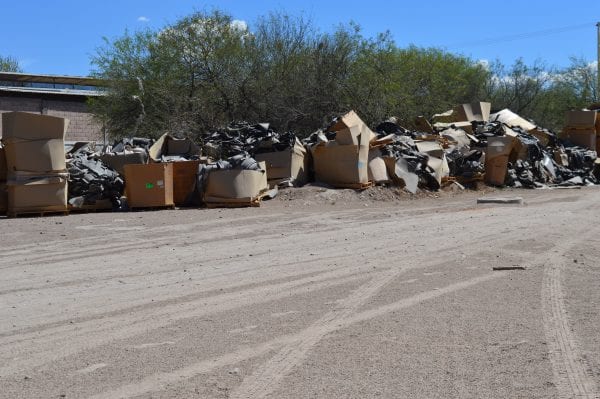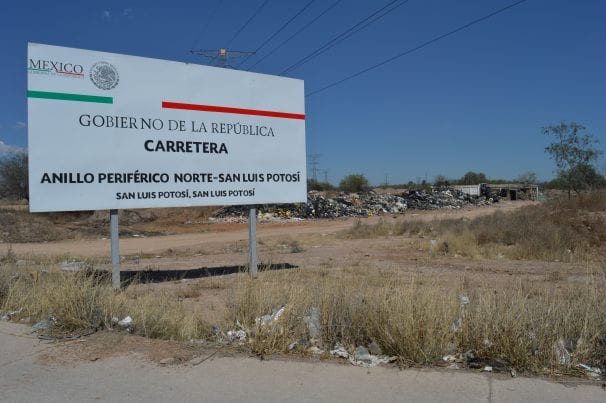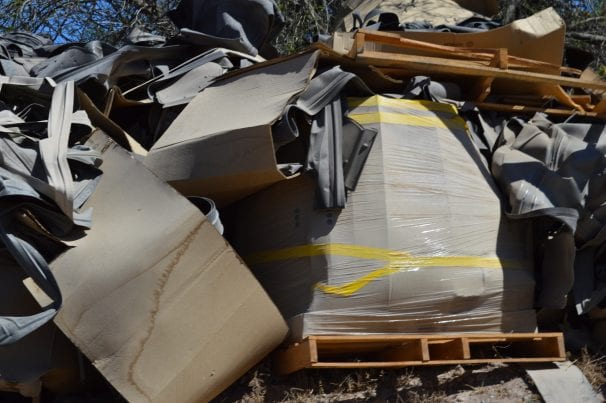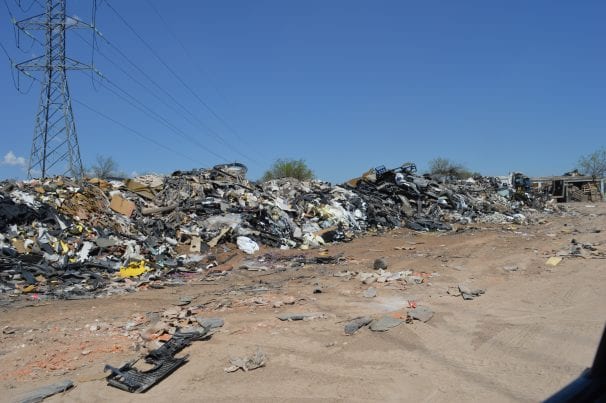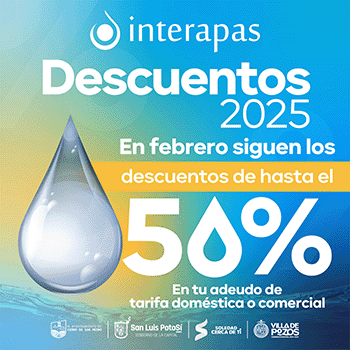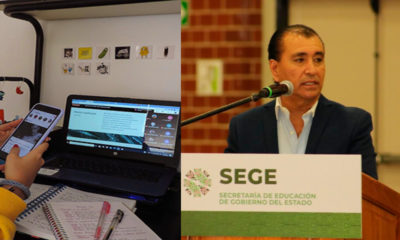ASAP
Draexlmaier is poisoning San Luis Potosí

97 percent of the industrial waste that the german company generates end in clandestine pullers, black market and brick stove ovens
By Roberto Rocha
Only 3.33 percent of the 2 thousand tons of industrial waste generated by the Draexlmaier plant located in San Luis Potosí, between September 2017 and September 2018, were deposited in authorized dumps, the destiny of the rest is unknown, although we found tons of their “scrap” in clandestine dumps, the black market and, according to environmentalists, they could also be used as fuel for kilns of highly polluting brickyards that are located in the periphery of the city. All under the concealment of the Secretary of Ecology and Environmental Management (Segam) of the San Luis Potosí government.
According to LaOrquesta.MX, during the investigation that began in June of last year, in the metropolitan area of San Luis Potosí there are two different clandestine dumps in which auto parts scraps manufactured by that company were found. These dumps do not comply with the Official Mexican Standard 083 which refers to the specifications of environmental protection on urban solid waste and those of special management
The first finding of this type of clandestine dumps found by LaOrquesta.MX is a materials warehouse located on Las Américas avenue, in the community of Rancho Nuevo in the municipality of Soledad de Graciano Sánchez, about five kilometers from the Ponciano Arriaga airport and behind the back of the Technological University of San Luis Potosí.
There, and despite the fact that the parts manufactured by Draexlmaier in San Luis Potosí are part of the temporary import program called Immex, and therefore can not be sold or invoiced individually, the reporter was able to buy, in what then was a black market, automotive parts of luxury vehicles that were rejected by the company in its interior plant, which since 2005 is located in the Industrial Zone of San Luis Potosí.
The Rancho Nuevo warehouse also exceeds the limits set by its own walls, and even invades a space of approximately 50 meters on the sidewalk of the avenue of the Americas, as well as an open terrain, adjacent to its location, in which hundreds of green boxes with the Draexlmaier logo are visible. These boxes are used by the German company as returnable component packaging. Said boxes are composed of PVC, polypropylene and polyester.
In the constant visits to the aforementioned warehouse, LaOrquesta.MX was able to acquire two armrests and a BMW truck console; a glove compartment for Mercedes-Benz vehicles, the safety curtain for a Tesla car and the interior door of a General Motors car, for a cost of less than 200 pesos. All the pieces acquired by the reporter had in relief the logo of Draexlmaier and also de logo of the construction company of vehicles: BMW, Mercedes-Benz, Tesla or GM.
According to what was reported by neighbors of that warehouse, the materials coming from the Draexlmaier plant are sold to pickup trucks of private owners and also to trailers of national companies that take the material in prices that range between 500 and 5,000 pesos.
Many of these products are also purchased -in the black market- by brickmakers in the north of the city to be used as fuel for kilns in the manufacture of bricks.
It was precisely in the northern part of the city, at the entrance to the community of Milpillas, where the second site with automotive waste pieces from Draexlmaier plants was found.
There, on foot of the Anillo Periférico Norte, on the sidewalk in front of the company Red Ambiental, we found more auto parts, also with the Draexlmaier logos and automotive reliefs.
Although there is still no evidence or study, the wastes deposited incorrectly in that site could be contaminating the subsoil of the area, while those that are sold to brickmakers of the community of Milpillas and the third and third Chica colonies would be contributing to a uncontrolled contamination of the air quality.
In that place, in the community of Milpillas, there are indications that industrial waste has been thrown out of the Draexlmaier company at least since December 2016, as can be seen in the Google Street View service.
Days before finishing this report, LaOrquesta.MX visited again both sites, verifying that the same conditions are maintained.
The materials found in both sites are made of polycarbonate / acrylonitrile butadiene styrene (PC + ABS), polypropylene (PP) and polyvinyl chloride (PVC).
|
Returning to the terms of NOM083, an industrial dump must be more than 13 kilometers from the center of the runways of an airport, must be outside the urban sprawl, must cover the waste at least once a week and avoid entry of animals, among other obligations. Circumstance that both found sites violate.
Regarding the issue, the Segam was questioned through the request for information 00686618, from September 13 of last year, the “Volume of industrial waste or scrap reported to the Secretariat of Ecology and Environmental Management by the company Dräxlmaier Components Automotive of Mexico, with address at Av Central 180, Zona Industrial, 78395 San Luis Potosí, SLP”.
The state agency replied that, from September 13, 2017 to September 13, 2018, the German auto parts manufacturer generated 72 thousand 808 liters, 51 thousand 160 pieces or 2 million 134 thousand 145 kilos of scrap.
The request for information also includes the “Names of the companies that perform the final disposal of waste generated by Draexlmaier Components Automotive de México”. They replied that Triturados Pétreos de San Luis, SA de CV is in charge of that.
LaOrquesta.MX also requested the quantities of industrial waste that Draexlmaier “leads to final disposal”, to which the Segam responded that 72 thousand 808 liters, one thousand 97 pieces or 71 thousand 100 kilos of scrap were deposited in Stone Crushers of San Luis .
That would mean that, in the measurement of liters of waste, Draexlmaier made correct final disposal in 100 percent, but in terms of parts and weight of its scrap the difference between the deposited correctly and the declared is 97 percent
The 1,097 pieces that Draexlmaier would have brought to final disposal, according to Segam’s response, represent only 2.14 percent of all the materials that the company generated in a year. In terms of tonnage, the 71.1 tons reported in the information request only amount to 3.33 percent of the 2 thousand 134 tons that the company generated between September 2017 and September 2018.
Inexplicably, Segam’s response to the request for transparency dates from August 24, 2018, although the request for information was made until September 13 of last year, 20 days later.
To contrast the information provided by Segam in the request for information, LaOrquesta.MX visited the facilities of the company Crushed Petrus San Luis SA de CV in October 2018. There, a representative of that industrial waste collection company confirmed that they had received around of 71 tons of scrap from Draexlmaier in the last year, but also showed documents that indicate that, at least in the months of August and September of 2018, not a single gram of waste had been sent by the company.
Triturados Pétreos de San Luis, SA de CV, also informed the reporter that most of the industrial waste they receive from Draexlmaier consists mainly of rags and not automotive PC + ABS, PP and PVC parts.
TRITURADOS PÉTREOS DE SAN LUIS HAD A DENUNCIATION FOR CLANDESTINE SHIELDS
On October 17, 2017, the newspaper La Jornada San Luis published a note signed by the reporter Angélica Campillo, entitled “Company collecting industrial waste throws them in clandestine dump”, in which the chemical engineer Carlos Alvarez Flores reported that he had submitted before the Segam a complaint against Triturados Pétreos de San Luis, SA de CV for that anomaly. The text of La Jornada can be found in this link: (http://lajornadasanluis.com.mx/politica-y-sociedad/empresa-recolectora-desechos-industriales-los-arroja-tiradero-clandestino/).
In a new information request dated October 3, 2018, LaOrquesta.MX required from Segam the same data from the previous transparency order, plus “the final disposal site” for the industrial waste generated by Draexlmaier.
In the letter of response of Segam, dated October 8, 2018 and signed by Laura Michel Ortiz, Director of Environmental Management and addressed to the person in charge of the Unit of Transparency, Ma. Eugenia Torres Kasis, Michel Ortiz answered: “I do not omit to point out that the information required, had already been provided by memorandum number SEGAM / DGA / 043/2018 dated August 24, 2018, in response to the request for information registered with the number of folio 00686618, that the same The applicant made through the National Transparency Platform San Luis Potosí on September 13, 2018, with the exception of the one related to the final disposal site”.
Despite having recognized that there was an extra data in the application, Segam only responded “Triturados Pétreos de San Luis, SA de CV is the site where the final disposal of the waste generated by Draexlmaier is carried out”, without specifying the address nor geographic location of that space.
A new information request, dated February 5, 2019, insisted on the same data, but between September 1, 2018 and January 31, 2019.
Segam responded that Draexlmaier generated 39,300 liters, 29 thousand 173 pieces or one million 114 thousand 968 kilos of industrial waste, but between July 1 and December 31, 2018.
According to the response to this request for transparency, Draexlmaier took 100 percent of the liters and pieces it generated in the second half of last year to final disposal, but only 732,438 kilos of scrap, which represents 65.69 percent of the total.
In this latest request for information, Segam said that Draexlmaier’s industrial waste was taken to Triturados Pétreos de San Luis, but also to the companies Remeta, SA de CV and Juana María Cuello Sandoval.
INDUSTRIAL WASTE IN CLANDESTINITY
| Scrap produced by Draexlmaier from 13-Sep-17 to 13-Sep-18 | Scrap brought to final disposal from 13-Sep-17 to 13-Sep-18 | Percentage | |
| Liters | 72808 | 72808 | 100% |
| Pieces | 51160 | 1097 | 2.14% |
| Kilograms | 2134145 | 71100 | 3.33% |
|
Scrap taken to the company Triturados Pétreos de San Luis, SA de CV. Source: Segam |
|||
SCRAP’S DESTINATION IS UNKNOWN
| Scrap produced by Draexlmaier from 1-Jul-18 to 31-Dec-18 | Scrap brought to final disposal from July 1 to December 18 to December 31 | Percentage | |
| Liters | 39300 | 39300 | 100% |
| Pieces | 29173 | 29173 | 100% |
| Kilograms | 1114968 | 732438 | 65.69% |
| Scrap taken to the companies Triturados Pétreos de San Luis, SA de CV; Remeta, SA de CV and Juana María Cuello Sandoval. Source: Segam | |||
The justification of Segam to change the date of the request, was that the data sent to LaOrquesta.MX corresponds to the second semester report of the year 2018.
The Regulation of the Environmental Law of the State of San Luis Potosí in the Matter of Non-Hazardous Industrial Residues marks, in its article 35: “Once the non-hazardous industrial waste is deposited under any of the systems referred to in Article 33 (controlled confinements or special cells in sanitary landfills), the generator and, where appropriate, the management service company contracted for the final disposal, must submit to the Secretariat (of Ecology and Environmental Management) a monthly report with the following information: I. – Quantity, volume and nature of the deposited non-hazardous industrial waste; II.- Date of final disposition; and III.- Location of the final disposal site inside the confinement cell”.
That is, although Draexlmaier has hired a company to collect, transport and dispose of industrial waste correctly, the German company still has responsibility for the scrap it generates.
Article 41 also states that “The contamination of the soil produced by releasing non-hazardous industrial waste must be avoided, since this event may present risks to the natural elements and human health, so the Secretariat may require the remediation of the contaminated sites, in a well founded and motivated manner based on the Environmental Technical Standards and other applicable applicable provisions”.
On September 20, 2018, during the presentation of the third government report of the governor Juan Manuel Carreras, LaOrquesta.MXinterviewed Yvett Salazar Torres, head of Segam:
-How do you guarantee that companies make a correct final disposal of industrial waste?.
“In the case of special handling waste, they have to register as generators and they have to submit annual reports to us, to see which companies they are hiring for the final disposal of the waste. Now, within this permission that is given to them, they are already being requested from the beginning of this administration, to present a management plan. This management plan implies that they look for their waste that still has a value to be marketed to prevent a final destination. In other words, what is sought is that all the waste generated by them can be recycled or destined to a place where they do not reach a confinement or a disposal site and, obviously, this generates savings for the companies and we generate a environmental benefit”.
However, the pieces manufactured by Draexlmaier in San Luis Potosí are part of the Immex program, which allows the temporary importation of goods for the industrial sector, without the payment of taxes. Therefore, “The waste generated should receive special treatment, since at the beginning they were subject to a tax exemption or stimulus, and when they become waste, they remain under the temporary regime, which leads to certain obligations”-
Among the obligations generated by the Immex program is the traceability of the pieces until their final disposal and their impossibility to be sold without invoice.
According to Mexican Official Norm 083 (NOM083), which regulates garbage dumps throughout the country, final disposition is defined as “action to deposit or permanently confine waste in sites and facilities whose characteristics prevent the release to the environment and the consequent effects to the health of the population and the ecosystems and their elements”.
NOM083 also defines special handling waste as “those generated in production processes, which do not meet the characteristics to be considered as hazardous or as solid urban waste, or that are produced by large generators of urban solid waste”.
The same day of the third government report of Juan Manuel Carreras, to the question “in case the industrial companies do not comply with the correct final disposition of their waste, what sanctions there are?”, Yvett Salazar Torres responded:
“So far we have not found that any company does not comply, fortunately it has closed very well in terms of final disposal, because not only they report as generators, but we also have a registry of carriers and they also have to record which companies they are collecting. So, this implies that we can verify that they are giving the appropriate final disposition. In case we determine that the company is giving an inadequate final provision, an administrative proceeding against the companies is initiated. They have a time that the law marks so that they can present documentation that proves that it is not a waste generated by that company or that the disposition is being carried out well and in its case”.
On the other hand, LaOrquesta.MX learned that Draexlmaier not only incorrectly throws the waste generated by its plant in San Luis Potosí, but also brings those created in its factories in Lagos de Moreno, Jalisco and San Miguel de Allende, Guanajuato. This could be verified through the National Transparency Platform requesting the reports delivered by the company to the authority of said entities in the same period as that installed in the capital of Potosí.
In neither of the two states, nor Guanajuato, nor Jalisco, Draexlmaier registered industrial waste in that period of one year.
The State Institute of Ecology of Guanajuato responded that “once its database was reviewed, it did not locate a record or background on the environmental impact or integral management of waste for the Draexlmaier company”.
| 0
tons of garbage registered Draexlmaier in Jalisco and Guanajuato for a year. |
For its part, the Department of Environment and Territorial Development of Jalisco, reported that “there is no record of regularization on behalf of the company Draexlmaier Components Automotive of Mexico, S de RL de CV so the information requested in subject of special management waste management plans or stages of integral waste management is unknown”.
Therefore – the response continues: “There are no reports from the Draexlmaier company, from the plant in Lagos de Moreno, between September 13, 2017 and September 13, 2018, nor the names of the companies that make the provision end of the generated waste, nor the quantities of industrial waste that leads to final disposal and the final disposal site, since there is no record of regularization on behalf of the company”.
The response of the Department of Environment and Territorial Development of Jalisco concludes: “The required information is not available, because the records of the internal administrative unit do not have a record of regularization on behalf of the Draexlmaier company, of the plant in Lagos de Moreno”.
LaOrquesta.MX also found that the North American Industrial Classification System Code 2018 (Scian) registered by the Draexlmaier plant in San Luis Potosí is 336320: “manufacture of electrical and electronic equipment and its parts for motor vehicles”, but also should be included in Scian 336360: “Manufacture of interior seats and accessories for motor vehicles”.
The environmental reviews made by the Federal Environment Secretariat (Semarnat) are made from the Scian of each company, so Draexlmaier would only be audited for one of the two plants that it has in this city, the electric one; while the other, the interior, which is presumed to generate the scrap found in clandestine landfills, does not receive a proper federal review.
The Scian classifies companies in Mexico, the United States and Canada, according to the economic items to which it is dedicated.
Luis González Lozano, representative of the environmental association Change of Route, said for La Orquesta that, from this report “the suspicion is that the Segam is not carrying out its work, and that the problem of the brickworks, first factor of air pollution in San Luis Potosí, will continue without any attention”.
“For Change of Route it is clear that there is no certainty that the Segam effectively revise, verify, supervise and prevent the brickworkers from using tires, oils, industrial waste, plastics, etc.”, said the representative of the organization.
González Lozano continued: “It is essential that the environmental authorities have a precise knowledge of the faculties and attributions that they should exercise, to care for and promote the care of the environment, and apply the corresponding penalties. Therefore they must apply the environmental law, always and in all its scope, must constantly review everything that damages the environment and avoid impunity, is the great challenge of Segam, an authority that has seriously failed the potosinos”.
“It is a pity that the government of the State tolerate the ‘environmental sclerosis’ in which San Luis Potosí lives”, concluded Luis González Lozano, the representative of the Cambio de Ruta organization, which since 2016 has promoted amparos seeking Segam to monitor to the air quality of the city of San Luis Potosí.
To counteract the effects of these amparos, in July of last year, Yvett Salazar Torres criminally denounced González Lozano, because the secretary of ecology considers that they are “acts of gender violence and harassment, as a woman and an official”.
LaOrquesta.MX asked the companies and agencies involved for an institutional position on this report.
Draexlmaier replied that the company is committed to corporate responsibility, including protecting the environment, “and asks its suppliers to review those principles.”
The German auto parts manufacturer also said that “Our suppliers are aware that we will not accept any breach of the laws and our regulations. If such a case were detectable in our supply chain, we will take immediate countermeasures”, and that “we will immediately contact our external service providers to clarify the situation”.
For its part, Mercedes-Benz said that “it will take all indications of irregularities seriously and investigate them thoroughly”, so they contacted their supplier about these problems.
In the case of BMW, the company answered that “our objective is to maintain efficiency and transparency in our operations, as well as in the supply network to conserve the environment”.
From Sedeco, Segam, Semarnat and Tesla there was no response. General Motors could not be contacted prior to the close of this edition, since the piece of that vehicle located in clandestine dumps was acquired just the day before the publication of this report.
THE RESPONSE OF DRAEXLMAIER
- DRÄXLMAIER Group is committed to the principles of corporate responsibility, including the protection of the environment (link: https://www.draexlmaier.com/en/company/responsibility/ehs/), respects the law and asks its suppliers to review these principles, incorporate them into their own corporate policies and share them with their own supply chain.
- All DRÄXLMAIER Group plants are certified by the ISO 14001 standard and we expect our suppliers and their entire supply chain to adopt environmental practices that are sustainable, responsible and that promote the conservation of resources and raw materials according to ISO 14001 .
- Our suppliers are aware that we will not accept any breach of the laws and our regulations. If such a case were detectable in our supply chain, we will take immediate countermeasures.
- Waste disposal is delivered to an external service provider. As with all suppliers, our sustainability standards also apply to service providers.
- On our website you will find complete information about our sustainability standards, https://www.draexlmaier.com/fileadmin/Supplier/Dokumente/Nachhaltigkeitspolicy/2016-11-23_Supplier-Corporate-Sustainability.pdf
- At the same time, as usual in these cases, we will immediately contact our external service providers to clarify the situation.
MERCEDES-BENZ SAYS IT WILL INVESTIGATE THOROUGHLY
The company Daimler, owner of Mercedes-Benz, answered the request of LaOrquesta.MX to answer an official position regarding this report. The response of Mercedes-Benz is reproduced in full below:
Sustainability is one of the basic principles of our corporate strategy, as well as a point of reference for our success as a company.
Daimler requests and supports the responsible handling of materials.
For several years, we have defined the sustainability requirements that our suppliers must meet in our Supplier Sustainability Standards. These include environmentally friendly production and environmental responsibility.
http://engp-download.daimler.com/docmaster/en/html/SUPPLIER_SUSTAINABILITY_STANDARDS.2013-06._multi.html
We take seriously all indications of irregularities and investigate them thoroughly.
We have contacted our provider regarding this information.
The response from BMW, on the other hand, was much more austere:
Regarding the BMW Group, we share with you that our objective is to maintain efficiency and transparency both in our operations and in the supply network to conserve the environment. To ensure this, we maintain standards of sustainability and care for the environment throughout the entire value chain as an essential part of our environmental and social commitment.
For more information about sustainability standards in the BMW Group supply chain, visit the website: https://www.bmwgroup.com/en/responsibility/supply-chain-management.html
Also read: El Chato López wants the 14 thousand hectares of San Juan
ASAP
#MeToo exhibits potosino writer

La Orquesta collects two testimonies against AlfredoPpadilla, one of those who most complaints in networks has accumulated
By María José Puente
“True to my habits only as intelligent and insightful females, which in these days of Internet and palliatives are irretrievably difficult to find…”
Alfredo Padilla | April 2015
…
The previous fragment is part of a text that the writer Alfredo Padilla published in April 2015. Words more, words less, man uses prose to describe a relationship (in which the emphasis is placed on his superior qualities) with a girl that he fantasizes about killing her… to eat her.
…
Seldom as in San Luis Potosí, the #MeToo took on such a literal meaning, because the strenght of the movement at the national level and a first complaint with the HT #MeTooEscritoresMexicanos led a handful of girls to tie the ends of a history of harassmentvand intimidation that, for some, even, began a decade ago with a common factor: Alfredo Padilla.
“I did my internship in a visual arts magazine here in San Luis and one of my activities was to be in contact with the collaborators through Facebook. Then there was going to be an event and I had to be in contact with this person for logistics issues.
He would answer what he had to answer, but he always took the opportunity to mention something about my body. First it started very light and then it was increasing in tone. First, it was like, “you are very pretty” and then it was like “I like some part of your body”, until I got to “I dreamed with you and I want to do this to you”.
The experience of Diana* occurred almost 5 years ago and although she denounced the artist’s attitude, her superiors dismissed the story arguing “no, they have known him for years, he has a family, he may be confused”.
Nothing happened.
“Get the cross into your pussy”
Years later, while Adriana *, another girl, read a text of her authorship in a cultural event, the writer listened to her and at the end of her speech he addressed her:
“They introduced us, we had friends in common and he told me that he really liked my texts and that is the first approach, the first contact we made. He asked for my mail, he even asked me for my texts, he asked me if he can get them and I said yes”.
I had read it before; I was cool about some things he said and I was touched by the idea that a writer I knew would also like my work. I just gave him my email, but then he sent me a message via Instagram and starts following me through that network. “
…
As described in his text and as reported by the victims, Padilla has made social networks his habitat to stalk and with this he seems to have added his victims to the only official statistics that the Inegi has published on the subject, in 2015: At least 9 million women in Mexico have been victims of cyberbullying.
At first, the writer sought to entangle Adriana with the false promise of placing some of her texts in the spaces that published it, argument that fell when the girl met another girl, also possible victim of Padilla, and with whom she worked in a cultural cut fanzine. He never mentioned the possibility of including the promised texts.
“Then he asks for my WhatsApp. We started talking about it and the questions become a little more personal, such as what I do, where do I work. When I told him that we could not date there was some discomfort.
He started to get annoyed when he started insisting on dating me and when he started to be insistent on whether I liked him. I told him that I did not like him. At that time I also told her that I had a boyfriend.
Suddenly one day, out of nowhere, he asked me: what color are your panties today? I know how easy it would have been to block it, but I did say, “Hey, not these questions; I’m not comfortable. “
Sometimes he blocked me when I told him that I was not interested if our relationship was not strictly laboral. Then he talked to me again and again, his harassment was more direct and he continued to ask me questions of a more sexual connotation.
I remember once fighting through WhatsApp. That was the time I blocked him from that network because I told him that I was not interested and he, I remember a lot of this phrase: he told me then to put the cross in my pussy”.
…
Both Diana and Adriana work in professional fields that constantly cross the circle of their aggressor, so it was not surprising that, after sharing some details, they discovered that both had been their victims and that there could be more. And they found them.
Since March 23th, when #MeTooEscritoresMexicanos started its climb on Twitter, Padilla was placed as one of the characters that accumulates more complaints, even equating to the profile of Herson Barona, the protagonist of the case that triggered the digital movement.
For the victims of the Potosino writer, that was the green light to make public their denunciations, some openly and others anonymously, the latter characteristic that has provoked the turn of the digital discourse around the legitimacy of the claims and the appropriate forms of formalize the accusations.
In this regard, Urenda Queletzú Navarro Sánchez, an academic from the Autonomous University of San Luis Potosí and an activist for women’s rights, dismisses the criticism:
“It is expected that, given the insufficient response from the State, the authorities in the different areas where young women have manifested the violence committed against them, that they resort to this type of movement, which allows them to enunciate all their aggressors and their violence and, above all, that have allowed them to find in the public space others who have experienced the same violence or with different magnitudes”.
The activist refers with irony that shortening the options of victims to the bureaucratic labyrinth of imparting justice in public institutions is to act on the only guarantee of impunity.
“It is well known among those who get involved with the courts that, if they do not mobilize before a violent death, much less they will mobilize before a complaint that they consider to be a normalized cultural practice; that is, the state apparatus is not willing to move beyond what women themselves have forced them to move in the face of the emergence of feminicidal violence.
How can we expect them to respond to our complaints of harassment if, with what is extreme, they do not mobilize?”
On more than one occasion, Potosinos officials whose jurisdiction is the Security or the Procurator of Justice, have emphasized that violence against women is a matter of cultural nature that develops in the family and that in that is protected and encouraged.
For example, during his appearance before the State Congress, in mid-2018, Federico Garza Herrera, Attorney General of the State, suggested that women are also omitted as they often do not report cases of violence or do report them and then repent.
In this context, in which the San Luis Potosí authorities demand that women “do their part” to enforce their right to justice, more than one victim has lost his life at the hands of his aggressor because, after filing complaints and requesting measures of protection, these have not been executed.
…
In what is perhaps the most chilling point of her case, Adriana tells how, after having blocked all communication with her attacker, one day, upon arriving at her house, he was waiting outside in the company of an unknown man.
“I’m coming and since I’m outside I see that he is there waiting for me, away from the house, but looking towards the facade, toward the windows as if he had already ringed and was waiting for someone to look out.
I was very surprised and at the same time I became paralyzed and angry. The first thing I asked was: “What are you doing here?”, And he said: “I came looking for you”.
I said “you know that I have you blocked from all sides. You can not come looking for me like that at my house. “At that time there was a new pet, then I opened the door, I got to grab it, and in that they enter.
I had a low battery in my cell phone; I did not know what to do and I told them I was leaving. I sent a message to a friend, I tell him that this guy came to look for me and he says “I’m going there”.
Once inside the house, Alfredo begins to tell me: “you are nervous; why are you nervous? Why are you so tense? What’s up?”
I was afraid that they physically assaulted me, so one of my first actions was to open the window and I thought “if I have to shout, all the neighbors are going to listen to me”. He began to move around the house, I was very tense “plugged in” with the cell phone to the charger while waiting for my friend to arrive.
In a moment that I turn around they are making gestures with the head; they did not talk to each other, they communicated by shaking their heads. I felt that I could not move, I did not want to turn my back on them. He begins to insist on taking me where I was going to go and when I toldl him that a friend was coming, at that moment it was very, very fast, they left”.
…
The complaints that the author accumulates in the #MeToo range from attempts to drug his victims, sending unsolicited intimate images; and harassment in public and private places. What is worse, one of the victims claims that Padilla confessed to harassing but he was unable to contain himself.
Diana reports that after having made her complaint publicly on Facebook, at least three women have been recognized victims of the same person.
“There is a case of a girl who says that ten years ago she had a situation with him. I believe that (the complaint through the #MeToo) is also a way to alert more women and also to know who the aggressors are”.
Adriana considers that “now that she detonated and that Alfredo Padilla was appointed more times, in addition to those we knew, we were relieved to know that it was not our wave. That we were not inventing and that everything that happened is not our fault either.
I would like to say that I feel calm to know that I am accompanied by other women who are also pointing out and denouncing him publicly, but what keeps me feeling uneasy is thinking about women who still do not know this”.
…
In an ideal world, concludes Urenda Queletzú, the #MeToo should bring with it “that those aggressors inhibit their behavior. Let them know that, if they continue to rape women, women will come out and place their names in the public arena.
This has the possibility of subverting the situation that is generated between a victim and his victimizer, where he enjoys impunity, enjoys his non-existence and places the victim in a confrontational condition before him “.
…
La Orquesta: Are you afraid?
Diana: The truth is I’m not afraid for myself, but for the others. Of course, no aggression is minor but compared to other cases, I am not afraid of this person. It produces a lot of impotence and courage that still goes there as if nothing aggravated more women and nothing happens.
Speaking specifically about this aggressor, who has been operating in this way for years and who is still there in cultural spaces, in academic spaces, I am afraid of others.
Also read: Gender Alert is not a magic wand: says Caco Leal about femicides
ASAP
SLP City Council spends 320 thousand pesos on trips

Only the mayor registered per diems for 82 thousand pesos, in eight different visits to the CDMX
By La Orquesta
Between the beginning of the administration of Xavier Nava Palacios and January 12 of this year, the City of San Luis Potosí has spent 320 thousand 826 pesos with 69 cents in 41 trips made by municipal workers in those first 103 days of the mayor’s office.
This represents an expense of 7 thousand 825 pesos for each trip made by municipal officials.
The daily average of travel expenses in the City of San Luis Potosí for that period was 3 thousand 114 pesos.
Only the mayor Xavier Nava Palacios spent 82 thousand 402 pesos in eight different trips, all to Mexico City.
The first one, on October 18 of last year, for 11,647 pesos, was to visit the State Water Commission and Pemex. Then, on November 19, Nava Palacios visited the Tax Administration Service with a cost to the treasury of 10,567 pesos.
On November 30, the mayor spent 4 thousand 582 pesos on a trip to Mexico City to take a protest as vice president of the National Association of Mayors. For that same trip there is a charge for 3 thousand 711 pesos.
Then, on December 12, Nava Palacios traveled to a meeting with members of the Budget Committee of the Federal Chamber of Deputies, with a charge to the treasury for 8 thousand 526 pesos.
In three meetings with the Federal Electricity Commission, in an attempt to have the municipality’s debt for the electricity service condoned, on the pretext that it was necessary to cover the expenses of the Interapas, the mayor spent a total of 43 thousand 639 pesos.
The first trip, from January 7, had a cost of 11 thousand 690; the second, ten days later, cost 12 thousand 240 pesos. For the third, on January 22, the mayor spent 19 thousand 709 pesos.
Other expenses in travel expenses, although not made by the mayor Xavier Nava Palacios, were carried out for work tables on public security issues.
On October 24 of last year, a total of 21 thousand 925 pesos in travel expenses was paid to a guest for these meetings. Another payment, for 20 thousand 919 pesos, had been made on October 3.
On January 9, 14 thousand 914 pesos and 10 thousand 102 were paid on December 12. The lowest payment for this concept was for 5,652 pesos, on October 24.
A payment of per diems for 18,121 pesos allowed the director of Catastro, Patricia Rodríguez Álvarez, to travel to the National Real Estate Congress of Oaxaca, on November 28 of last year.
The director of municipal tourism, Yara Mariana Nagore Rojas spent 14 thousand 368 pesos on a trip to the Chocolate Festival in Tabasco, in November last year.
The technical secretary of the City Council, Jorge Francisco Arias Hernández, spent December 4 last year 12 thousand 333 pesos in a visit to the National Commission for the Efficient Use of Energy, for an assignment that was called “infrastructure projects for the municipality”.
In a working visit to Zapopan, Jalisco, according to the way in which those travel expenses were described by the transparency area of the City Council, the director of Economic Development of the municipality, María Esther Velázquez Esparza, spent 11,110 pesos.
Also read: Deputies will analyze illegal purchases of the City Council of SLP
ASAP
Gender Alert “is not a magic wand”: says Caco Leal about femicides
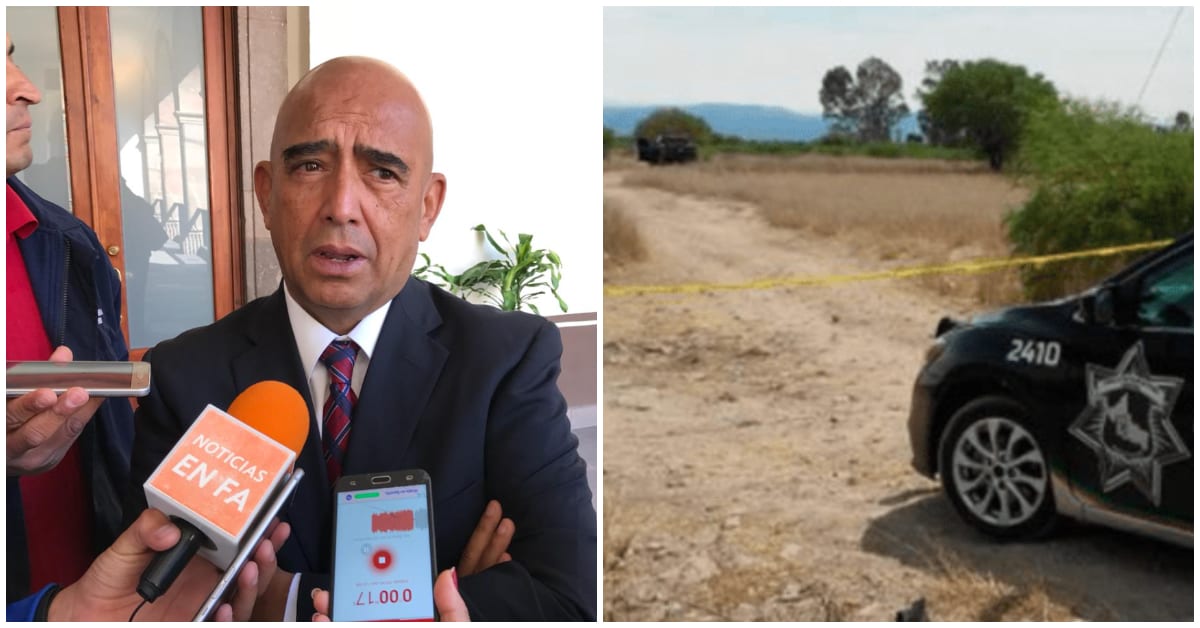
The State Human Rights Commission affirmed that the Secretary of Public Security fail to implement security and prevention measures in cases of violence against women.
By Josè Luis Vázquez
The Secretary General of the Government of the State of San Luis Potosí, Alejandro Leal Tovías, stated that the Gender Violence Alert issued in different states of the Republic is not a “magic wand” that avoids femicides.
These statements come after the State Human Rights Commission (CEDH) affirmed that the Secretary of Public Security and the Attorney General of San Luis Potosí fail to implement security and prevention measures in cases of violence against women.
“We are complying with what the Gender Alert says, but it is not a magic wand that solves the situation nor have the femicides automatically descended, it is an effort of all, we all have to enter this to give certainty and security to women”, he said.
In that sense, the official explained that the Gender Alert issued in six municipalities of the state “is a regulation and a route to meet a series of requirements for prevention, however, this is not a limitation for the government, we are working enormously in this, the great advantage is that most of the femicides have been solved, more than 70% are intrafamilial problems, of couple, of courtship”.
Then he added: “this does not justify or give us peace, we continue working, doing polygons in colonies with new security strategies, (…) that there is a certainty that all women could travel at any time of the day, we have not failed, but we have a lot to do”.
When mentioning that the CEDH affirmed that several femicides registered in San Luis Potosí could be avoided with a proper coordination of authorities, he said: “we have avoided many cases thanks to shelters and women’s centers, there are others that we have not managed to avoid, but this is not a justification, it’s good that we can do it, but we need zero tolerance “.
Also read: CEDH seeks Gender Alert for three more municipalities of SLP
-
Destacadas1 año
Con 4 meses trabajando, jefa de control de abasto del IMSS se va de vacaciones a Jerusalén, echando mentiras
-
Ciudad3 años
¿Cuándo abrirá The Park en SLP y qué tiendas tendrá?
-
Ciudad3 años
Tornillo Vázquez, la joven estrella del rap potosino
-
Destacadas4 años
“SLP pasaría a semáforo rojo este viernes”: Andreu Comas
-
Estado2 años
A partir de enero de 2024 ya no se cobrarán estacionamientos de centros comerciales
-
Ciudad2 años
Crudo, el club secreto oculto en el Centro Histórico de SLP
-
#4 Tiempos2 años
La disputa por el triángulo dorado de SLP | Columna de Luis Moreno
-
Destacadas3 años
SLP podría volver en enero a clases online


